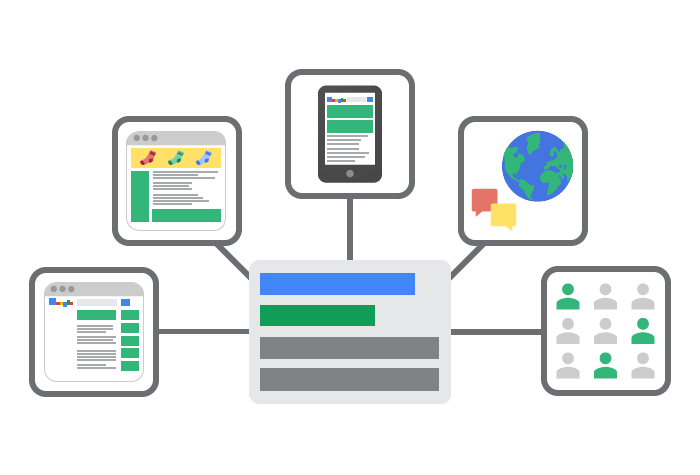While you’d expect your SEO efforts to pay off in the long term, it’s possible that you’re not implementing a few quick SEO tips and tricks that could work wonders for your website. If there are any lessons to be drawn from the events of the past year in the search engine world, one of them is that Google is making it harder for webmasters to get away with low-value optimization schemes.It’s already tough keeping up with all the Panda algorithm updates, and with more expected to be rolled out in the coming months, it’s best to be on the safe side with ‘clean’ SEO tactics that will work now and in the future. Whether your SEO goals are short-term or long-term, here’s a handy list of fixes that are sure to do your blog/website less harm than good.
#1: Diversify Anchor Text
The industry standard, up until now, is to always use keywords in the anchor text that links to your content. That sounds fine, but not when every single one of your inbound links uses the exact phrase as anchor text. Maybe you have a site that sells affordable dog food. If you are trying to rank for the keyword “Affordable dog food” and have 500 links all using the exact same phrase pointing to your page, you’re doomed. Nothing screams “spam!” to Google more than that.
The logic for having a variety of anchor text is simple: Google expects you to build links naturally. You are not supposed to pay for links – using the same anchor text everywhere is a sign – you must earn them through the value you provide. So stop obsessing over anchor text, because the context of your links is even more important in assessing its quality. Dr. Pete of SEOmoz has a great example on a spammy links inand why you must diversify not just your anchor text, but your marketing as well.
#2: Use Google Hangout Videos for SEO
Videos have always been an effective SEO strategy and it’s a plus that web users prefer them to reading. This trick will work best if you’re on Google+ and using Google+ Hangouts. Make a few quality videos and you’ll be surprised at the spike in exposure that you’ll be getting for your business.
Getting your video ranked for keywords in your niche can be advantageous, especially when no other video appears in the SERPs. It offers users variety. But a regular YouTube video may not get you indexed faster or higher than a YouTube video recorded through a Google+ Hangout. So get to learn how you can set up a Hangout and stream it live on YouTube, and then later edit that video and optimize it for the keywords that you want to rank for. In a matter of hours, you should expect your video in the top 10 search results for your target keywords. Does this really work? Well, here’s proof.
#3: URL Canonicalization
Many webmasters do not realize just how easily they dilute the value of their links and let their content appear as duplicate by not implementing canonicalization fixes. Let’s say you create a blog and your homepage can be accessed through www.example.com or example.com/ or www.example.com/index.htm. This creates a problem because there appears to be 3 different pages all with the same (duplicate) content. The value of inbound links to your homepage also reduces, since the link juice is shared out among the 3 ‘pages’.
This can be resolved by creating a permanent 301 redirect that will direct your pages to point to the same URL. This ensures that all your non-www versions of your pages are redirected to the www versions. The fix is crucial as it prevents search engines from seeing two versions of your website.
#4: Optimize Page Titles and Meta Descriptions
Onsite SEO may not weigh in as much as offsite SEO, but still, what have you got to lose if you can quickly tweak your pages for optimal search engine rankings? You can tune up your site structure, page titles and meta tags and even the loading speed of your website or hire someone to do this for you. Don’t forget that SEO begins with keywords, so your titles must show that you’re relevant for those keywords.
If you are using WordPress, there are a number of SEO plugins that will help you with the page titles and meta description of your content, as well as the popular W3 Total Cache plugin which helps speed up your site’s loading speed.
#5: Create and Verify your Google & Bing Local Listings
So Google replaced Google Places with Google+ Local, which may seem like much to process, but the good news is that there are SEO benefits that come with this change. Interacting with your customers has certainly been enhanced since you can easily engage them through your Google Plus pages, and they can +1 your content when they like it.
Google+ Local is certainly a ranking factor, so create your page if you haven’t already, or claim your listing. The same can easily be done for Bing Local. Keep in mind that search is becoming more localized, so you must move to take control of all of your business profiles (such as on Yelp and Foursquare) and the search engines will take note of this.
#6: Quality Content Rules
Finally, the bad old days of putting together a load of gibberish content on your website and then inserting the relevant keywords are gone. Search engines now have smarter algorithms that can separate content farms from quality posts. So to be able to impress Google and Bing, you must first fascinate the human readers with the quality of your content.
Write original, interesting material. Avoid thin content. Write for humans. The only way you’re going to build an audience, whether by guest blogging or through the posts on your blog is by writing compelling stuff. When you do this, people will be sharing your content on social networks. That’s great for SEO. And there’s a bonus: you also get lots more traffic without so much relying the same search engines.




